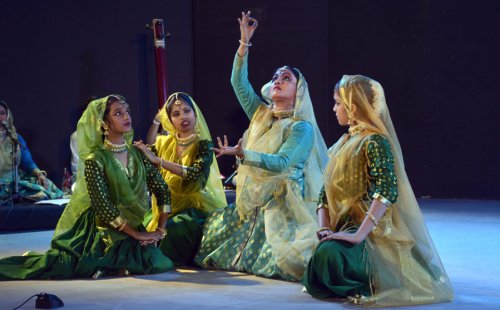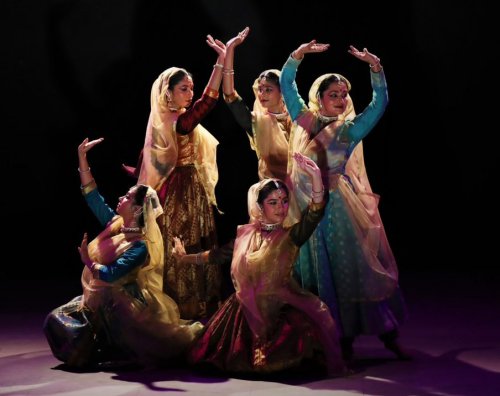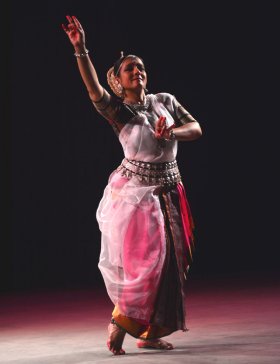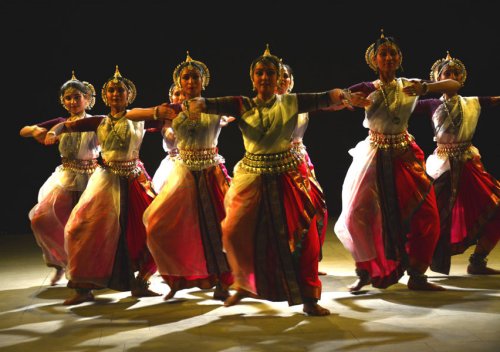
|   |

|   |
Evoking the sublime - Anand Nandi e-mail: anandnandi30@gmail.com Photos courtesy: Mahagami June 22, 2019 Come April and one observes a wave of enthusiasm amongst dancers and dance organizations looking at different ways of celebrating World Dance Day. Owing to the efforts of a revered dance Gurukul MAHAGAMI, Aurangabad has been witness to a growing interest of people for innovative designs created through traditional dances. Parwati Dutta, Director and Guru of Mahagami, has been the creative force behind curation and presentation of many such unique festivals and showcases in the past 23 years. This year, World Dance Day at Mahagami was celebrated through a 2-day festival titled Vistar that brought forth some of the path-breaking works of Parwati Dutta in Kathak and Odissi.   The following Dhrupad was an exceptional piece based on a traditional bandish evoking the concept of Hari-Hara. The rhythmic delineation taking offbeat and fractional positions of vilambit chautaal traveling with majestic patterns on sonorous pakhawaj brought a new dimension to exploring the Dhrupad bandish. The Dhrupad 'Bansidhar Pinaakdhar' was presented by senior disciples of Parwati Dutta with an ideal combination of fluidity and restraint. Taal Ashtamangal, a time cycle of 11 beats got an unusual treatment through the Dhrupad sensibility in the next piece in which the sensuality of the taal was celebrated through richly textured rhythmic passages interspersed with silent spaces in space and time.  Parwati Dutta  The second evening of Vistar was focused on Odissi performances by the Mahagami ensemble led by Parwati Dutta. The compositions were based on Rabindra Sangeet and Rabindra Sahitya. The opening piece was a Mangalacharan based on a Bengali poem invoking the true spirit of dance and the ideal virtues of mankind: 'Jaago nirmal netre.' Parwati presented a solo abhinaya on a serene melodic passage without any rhythm which described the wandering mind of a seeker and the bewildered heart that is mesmerized by the echoing flute. A poem with a deep touch of pain, separation and longing, the rendition filled one's heart with surrender to the absolute. A rhythmic passage followed that was devoid of percussion; instead the flute patterns suggested the sublime rhythm and created an aura of the divine flute player. The highlight of the evening was Vadya Pallavi. Parwati says: "Pallavi are of 2 types - Svar Pallavi and Vadya Pallavi. During revival of Odissi in 1950s, while the former was restructured the latter could not be attempted." Through her long time association with Guru Banamali Moharana, she worked towards identifying the lost Odissi taal and the traditional compositions of mardal. Vadya Pallavi is an outcome of her research and exploration with Odissi rhythm that has been performed in important festivals. Beginning with a leisurely Arasa in Jatitaal, the pallavi unfolds with maana from different points of the taal and the intricate patterns in different jaatis. The final crescendo is with fast paced rhythm and movements by the dancers creating kaleidoscopic designs in space. It was a delight to watch the well trained disciples of Parwati learning at Mahagami Gurukul under guru-shishya parampara. World Dance Day celebrations were held in a couple of other institutions too in the city. This reviewer missed some parts of the performances but was able to catch a glimpse of Bharatanatyam dancer Vaibhav Arekar's solo on Debotar Grash. A thinking artist, he is often seen using the dance technique to interpret various concepts. While some parts in his performance brought fresh approach to the form, some were repetitive aimed at showing only the physical prowess instead of looking at the depth. Another performance was by a local dance student Kannagi Gosavi who mostly performed on poor quality taped music with little clarity of form and purpose followed by an amateur presentation by untrained Odissi dancers who were supposedly her students. One wondered why do less trained enthusiasts lack patience and perseverance to learn properly before attempting a stage performance. The dance world is blessed with a wide range of the capable and ignorant and surprisingly the world dance day gets celebrated by all. |